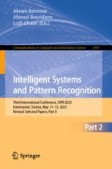Search
Search Results
-
Active self-training for weakly supervised 3D scene semantic segmentation
Since the preparation of labeled data for training semantic segmentation networks of point clouds is a time-consuming process, weakly supervised...

-
Self-training involving semantic-space finetuning for semi-supervised multi-label document classification
Self-training is an effective solution for semi-supervised learning, in which both labeled and unlabeled data are leveraged for training. However,...

-
Bird Species Recognition in Soundscapes with Self-supervised Pre-training
Biodiversity monitoring related to bird species is often performed by identifying bird species in soundscapes recorded by microphones placed in the...
-
Semi-supervised self-training approach for identification of non-referential pronouns and ellipsis in arabic texts
The identification of non-referential pronouns and ellipsis position is crucial for the Anaphora and Ellipsis Resolution task which is necessary for...

-
SSGait: enhancing gait recognition via semi-supervised self-supervised learning
Gait recognition is a challenging biometric technology field due to the complexity of integrating static appearance and dynamic movement patterns in...

-
Self-supervised discriminative model prediction for visual tracking
The discriminative model prediction (DiMP) object tracking model is an excellent end-to-end tracking framework and have achieved the best results of...

-
Self-supervised Cascade Training for Monocular Endoscopic Dense Depth Recovery
Dense depth prediction for 3-D reconstruction of monocular endoscopic images is an essential way to expand the surgical field and augment the...
-
Integrated self-supervised label propagation for label imbalanced sets
Label propagation is an essential graph-based semi-supervised learning algorithm. However, the algorithm has two problems: how to effectively measure...

-
Domain Adaptation for Speaker Verification Based on Self-supervised Learning with Adversarial Training
Speaker verification models trained on a single domain have difficulty kee** performance on new domain data. Adversarial training maps different...
-
DISET: a distance based semi-supervised self-training for automated users’ agent activity detection from web access log
Detecting automated users’ agent activities at any web application through users’ web access logs is a challenging issue. Many machines learning...

-
Improving Semi-Supervised and Domain-Adaptive Semantic Segmentation with Self-Supervised Depth Estimation
Training deep networks for semantic segmentation requires large amounts of labeled training data, which presents a major challenge in practice, as...

-
Series2vec: similarity-based self-supervised representation learning for time series classification
We argue that time series analysis is fundamentally different in nature to either vision or natural language processing with respect to the forms of...

-
Self-supervised approach for diabetic retinopathy severity detection using vision transformer
Diabetic retinopathy (DR) is a diabetic condition that affects vision, despite the great success of supervised learning and Conventional Neural...

-
Pairwise-Pixel Self-Supervised and Superpixel-Guided Prototype Contrastive Loss for Weakly Supervised Semantic Segmentation
Semantic segmentation plays an important role in many fields because of its powerful ability to classify each pixel efficiently and accurately, but...

-
An Evaluation of Self-supervised Pre-training for Skin-Lesion Analysis
Self-supervised pre-training appears as an advantageous alternative to supervised pre-trained for transfer learning. By synthesizing annotations on...
-
Auto CNN classifier based on knowledge transferred from self-supervised model
Training with unlabeled datasets using self-supervised models has the edge over training with labeled datasets, reducing human effort, and no need...

-
Impact of Autotuned Fully Connected Layers on Performance of Self-supervised Models for Image Classification
With the recent advancements of deep learning-based methods in image classification, the requirement of a huge amount of training data is inevitable...
-
Contrastive disentanglement for self-supervised motion style transfer
Motion style transfer, which aims to transfer the style from a source motion to the target while kee** its content, has recently gained...

-
Self-supervised pairwise-sample resistance model for few-shot classification
The traditional supervised learning models rely on high-quality labeled samples heavily. In many fields, training the model on limited labeled...

-
Self-supervised Siamese Autoencoders
In contrast to fully-supervised models, self-supervised representation learning only needs a fraction of data to be labeled and often achieves the...
